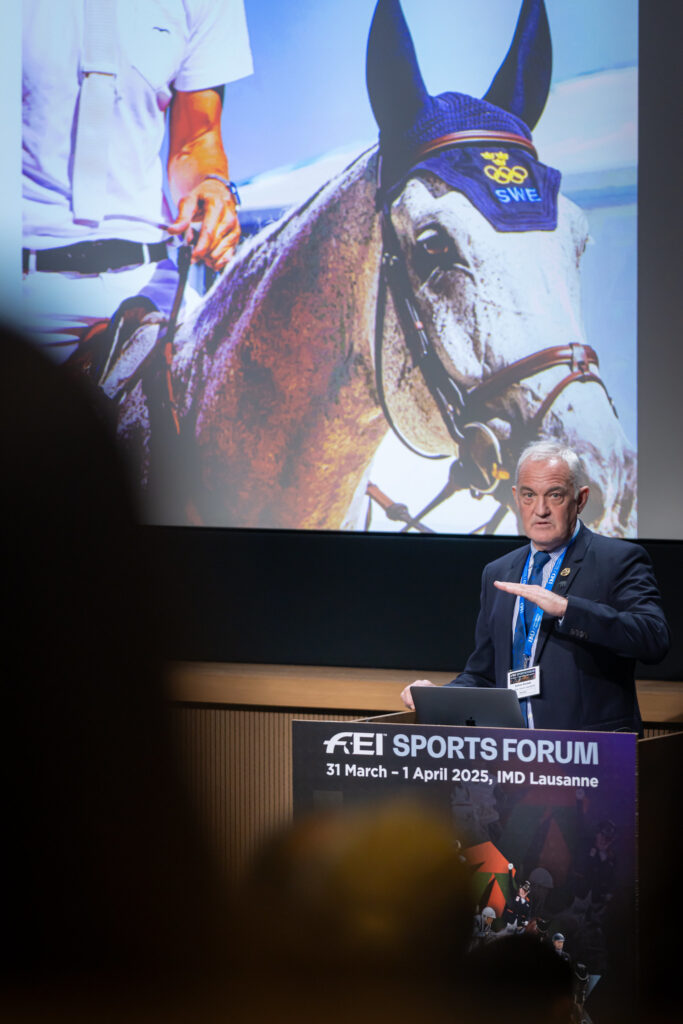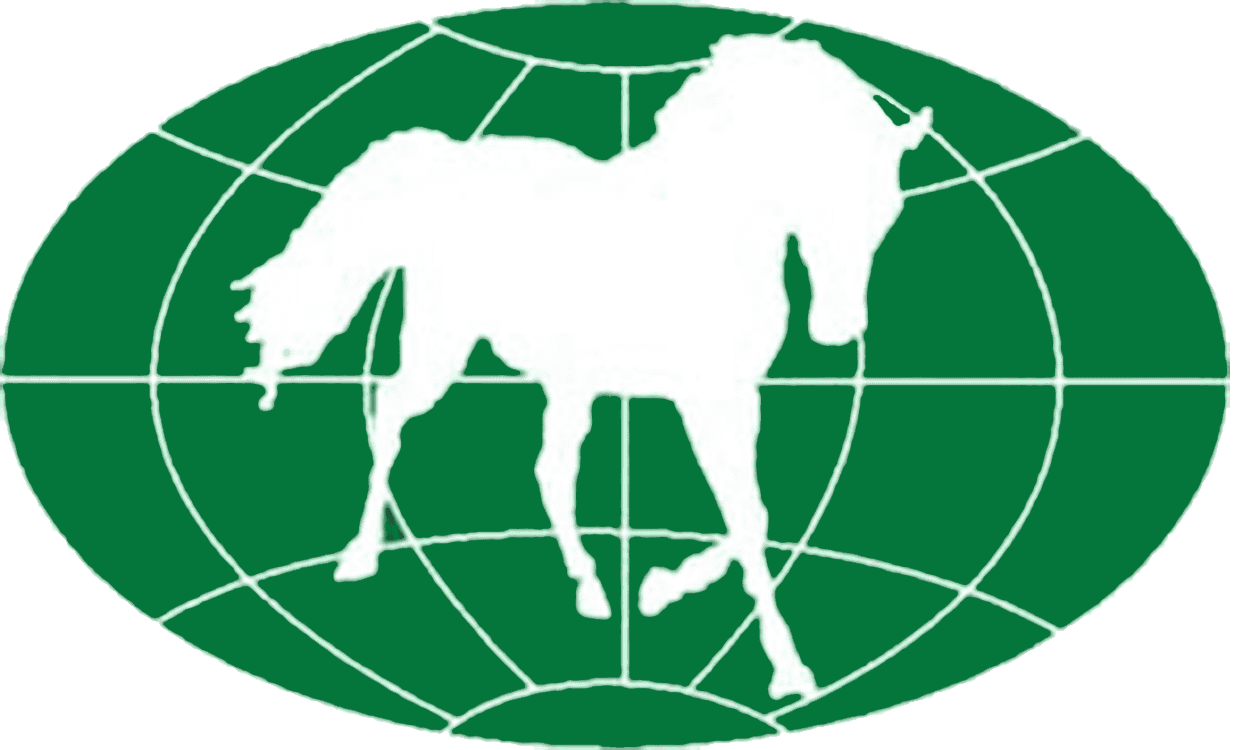The third session of the FEI Sports Forum 2025 delivered a sweeping and deeply detailed update on the implementation of the FEI Equine Welfare Strategy Action Plan. Led by Somesh Dutt, Senior Manager of Equine Welfare Initiatives & Implementation, the session featured key insights into ethical training, fitness to compete, scientific research, and the launch of the FEI Equine Welfare Advisory Group (FEWAG).
A Permanent Welfare Watchdog
Dutt began by announcing the formation of the FEI Equine Welfare Advisory Group (FEWAG), a permanent, independent body created to guide and assess the ongoing implementation of the Action Plan. The group is chaired by FEI Veterinary Committee Chair Dr Jenny Hall (GBR) and includes internationally recognised experts such as Dr Andrew McLean (AUS), Professor Madeleine Campbell (GBR), Dr Malin Axel-Nilsson (SWE), Professor Inga Wolframm (GER), and Dr Roly Owers (GBR).
“These individuals bring not only world-class scientific and welfare knowledge,” said Dutt, “but also the political, behavioural and sporting understanding required to create meaningful change.” An athlete representative is expected to be confirmed shortly.
Dr Axel-Nilsson was also praised for her ability to bridge science and practice. With a PhD in ecology and animal welfare and experience in both academic and entrepreneurial settings, she was described as a key contributor to the FEI’s broader aim of implementing change through education and human behavioural understanding.

Ethical Training in the Spotlight
One of the central themes of the session was Action 1.1: Ethical Training Methods. Dr Malin Axel-Nilsson introduced the work of the FEI Expert Consultative Group, which brings together leading voices from all FEI disciplines to define a global framework for ethical horse training.
“We realised early that before we can regulate or register trainers, we must clearly define what ethical training really is,” said Axel-Nilsson. “And that means understanding how training affects horse welfare, both positively and negatively.”
The group’s objective is to produce a globally applicable framework that defines ethical training and identifies acceptable practices based on scientific evidence and expert consensus. Their proposed definition of ethical training methods includes minimising negative welfare effects, maximising positive ones, and achieving self-carried behaviour—without the use of physical force.
Axel-Nilsson emphasised that the work is ongoing and collaborative. “We need to make our arguments understandable to all parties—trainers, veterinarians, scientists, and regulators alike.” The group is also examining how these principles can be incorporated into national federation systems, including potential regulatory changes.

Dr Andrew McLean then took delegates on a deep dive into the proposed First Principles underpinning the framework. Drawing from decades of experience in equitation science, he emphasised that ethical training must respect equine learning processes, avoid anthropomorphism, and seek clarity through consistent aids and emotional stability.
“Equitation science is not a method,” said McLean. “It’s a set of hoops we must jump through—criteria that help us train with transparency, safety and empathy.”
He added, “If we tell the world we’ve trained a bird to sit on our arm, we must let go of its wings. That’s self-carriage.”
Both Axel-Nilsson and McLean highlighted the importance of recognising horses’ mental and emotional states, and ensuring that training takes into account not just physical cues, but also affective welfare. The goal is a horse that performs because it understands and accepts the training, not one that complies out of fear or coercion.
Fitness to Compete – From Inspection to Emotional Readiness

Dr Jenny Hall delivered an update on the Fitness to Compete forum held in Amsterdam, and shared insights into how FEI is reassessing veterinary evaluations under the lens of welfare. “Fitness is no longer just physical,” said Hall. “Mental state, rest after travel, even behavioural indicators are now part of the equation.”
The forum brought together a wide range of veterinary and welfare experts to consider new parameters for horse inspection. Topics covered included standardisation of inspection surfaces, integration of gait analysis technologies, and distinguishing between asymmetry and lameness.
“There are no appeals when a horse is declared unfit. That’s why we take this responsibility so seriously,” said Hall. She also emphasised the importance of developing behavioural assessment tools that can be as informative and reliable as physical evaluations.
Axel-Nilsson added further context by linking this work to the Five Domains model of welfare assessment, stressing that behaviour and mental health must be viewed holistically alongside physical indicators. “We are increasingly moving toward objective markers for stress and discomfort,” she noted.
Science, Behaviour, and Innovation

Following the strategic overview, FEI Veterinary Director Dr Göran Åkerström took the floor to present the latest developments in research and innovation supporting equine welfare. “We are investing more in scientific research than ever before,” said Åkerström, “because we know that good welfare must be evidence-based.”
He began with a review of how the FEI evaluates scientific input, including collaborations with external researchers and rigorous multi-stage review processes involving veterinary and biomechanics experts.
Among the featured projects:
- The Oral Cavity Project, aiming to assess and prevent bit-related injuries through new inspection protocols. Behavioural change science is being used to ensure stakeholder engagement.
- The Footing Study, led by Dr Lars Roepstorff, which uses digital models to assess how surfaces affect limb stress and injury risk. The study includes horses jumping up to 160cm with motion tracking and surface analysis.
- Sniffer Dog Detection, a groundbreaking initiative using trained dogs to detect micro-dosed substances in horse saliva during endurance vet checks. “It sounds like science fiction, but it’s already shown results in pilot studies,” the FEI team noted. The dogs can detect substances at concentrations lower than most labs, with saliva used to trigger follow-up testing.
Åkerström also spoke about the integration of scientific learning into practical tools, including digital inspections, new educational content, and partnerships with national federations. “This isn’t about doing research for its own sake,” he said. “It’s about translating science into tools that protect horses in the real world.”
The Five Domains model was also highlighted as a guiding welfare assessment tool, with tailored checklists being developed for both competition time and the horse’s other 23 hours. “It’s not just about what we see in the arena,” said Axel-Nilsson. “Welfare is a 24/7 responsibility.”
Q&A
FEI Sports Forum 2025 – Session 3
What was the main focus of this session? The session focused on the implementation of the FEI Equine Welfare Strategy Action Plan. Ethical training methods, fitness to compete, and welfare-focused science were the core topics.
What is the FEI Equine Welfare Advisory Group (FEWAG)? A new permanent body giving independent oversight of the Action Plan. Chaired by Dr Jenny Hall, it includes top experts from ethics, behaviour, science, and equestrian sport.
What did the experts say about ethical training? Dr Malin Axel-Nilsson and Dr Andrew McLean presented a proposed definition and a set of First Principles. “We must define what ethical training looks like—and ensure it is based on both science and shared values,” said Axel-Nilsson.
McLean added: “We must minimise harm, maximise benefit, and train for self-carriage—not compliance.”
How is the FEI redefining Fitness to Compete? Dr Jenny Hall shared updates from a recent forum: “Fitness now includes mental state, readiness after travel, and proper body condition—alongside traditional vet checks.”
What role does FEI Veterinary Director Dr Göran Åkerström play? Åkerström presented ongoing research projects, such as the Oral Cavity Project, the Footing Study, and sniffer dog testing in endurance. “We are translating science into real-world welfare tools,” he said.
What role does research play in this strategy? Research is driving much of the strategy, from new inspection protocols to digital modelling and behavioural analysis. The FEI is working closely with scientists to create policies rooted in data.
How does the Five Domains model fit in? It’s being used to guide assessments of equine welfare across all aspects of the horse’s life—not just during competition, but also during rest, training, and travel.
QUOTE’s
Somesh Dutt, FEI Senior Manager, Equine Welfare:
“These individuals bring not only world-class scientific and welfare knowledge, but also the political, behavioural and sporting understanding required to create meaningful change.”
Dr Malin Axel-Nilsson:
“Before we can regulate or register trainers, we must clearly define what ethical training really is.”
“We need to make our arguments understandable to all parties—trainers, veterinarians, scientists, and regulators alike.”
“We are increasingly moving toward objective markers for stress and discomfort.”
“Welfare is a 24/7 responsibility—not just what we see in the arena.”
Dr Andrew McLean:
“Equitation science is not a method. It’s a set of hoops we must jump through—criteria that help us train with transparency, safety and empathy.”
“If we tell the world we’ve trained a bird to sit on our arm, we must let go of its wings. That’s self-carriage.”
“We must minimise harm, maximise benefit, and train for self-carriage—not compliance.”
Dr Jenny Hall:
“Fitness is no longer just physical. Mental state, rest after travel, even behavioural indicators are now part of the equation.”
“There are no appeals when a horse is declared unfit. That’s why we take this responsibility so seriously.”
Dr Göran Åkerström:
“We are investing more in scientific research than ever before, because we know that good welfare must be evidence-based.”
“This isn’t about doing research for its own sake—it’s about translating science into tools that protect horses in the real world.”
